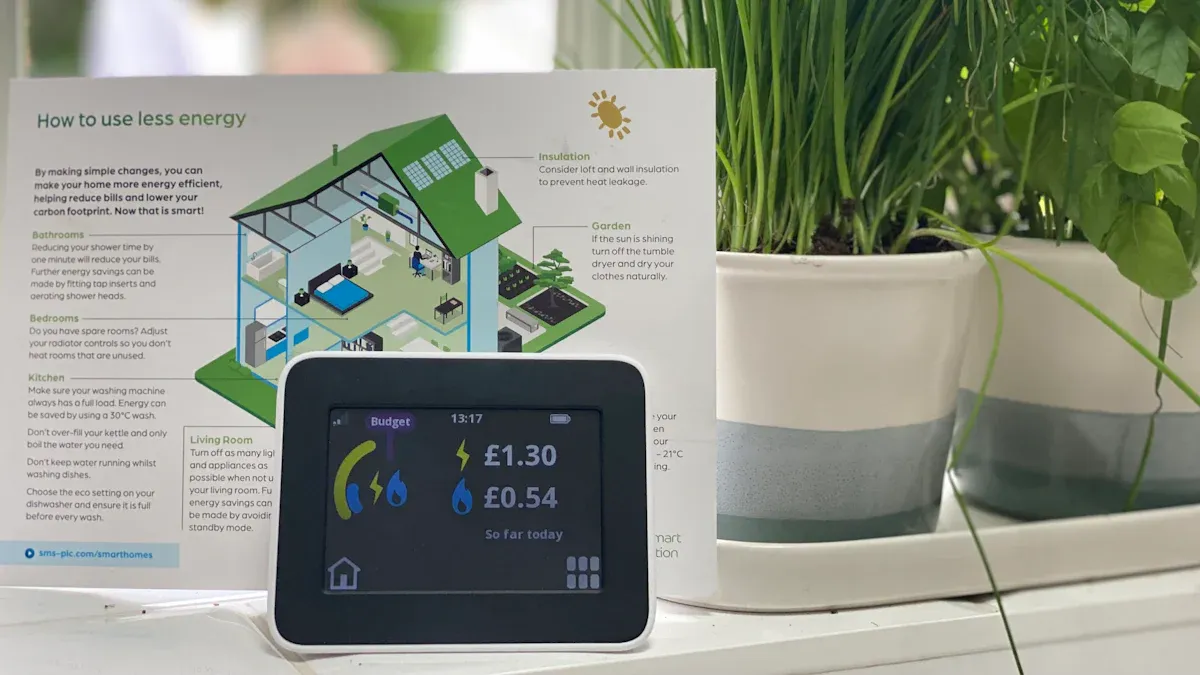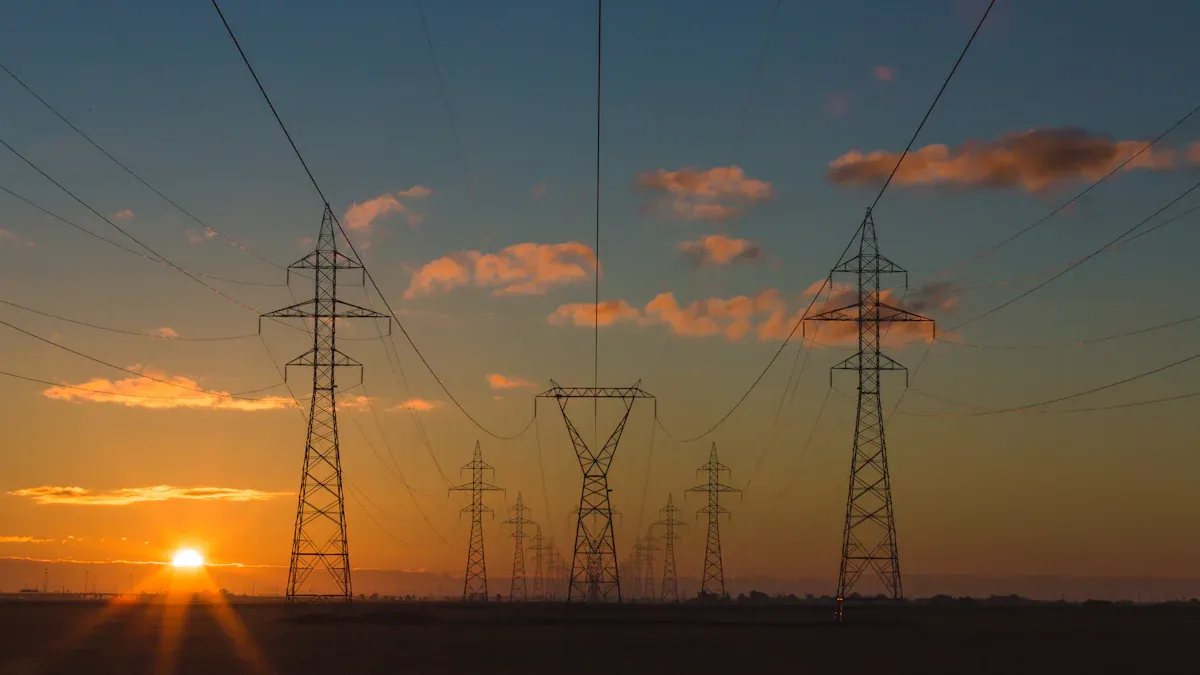What is the Role of AI in Renewable Energy Integration

AI in the energy industry is transforming renewable energy by addressing significant challenges. It helps predict energy needs and aligns supply accurately, reducing waste and enhancing the reliability of the power grid. By analyzing local weather patterns, AI improves the prediction of solar and wind energy production. Additionally, it optimizes battery storage by conserving energy during surplus periods and distributing it when demand peaks. These advancements highlight how AI in the energy industry enhances the efficiency and dependability of renewable energy systems.
Key Takeaways
AI helps predict renewable energy output to match supply and demand. This reduces waste.
AI keeps the grid stable by controlling energy flow and stopping overloads. It ensures power is reliable.
AI predicts equipment problems early, avoiding sudden failures. This saves money and makes systems last longer.
AI manages batteries to store energy better. It makes sure energy is ready when needed and helps batteries last longer.
Using AI in renewable energy lowers costs, works more efficiently, and reduces pollution.
Key Applications of Artificial Intelligence in Renewable Energy

Energy Forecasting and Demand Prediction
AI helps predict how much renewable energy will be made. It uses weather data, past records, and live updates to guess energy output. AI can predict energy from solar and wind sources up to 48 hours ahead. These guesses help match energy supply with demand, cutting waste and saving power.
AI tools make energy predictions more accurate.
They improve how energy is shared across the grid.
They solve problems with adding renewable energy to the system.
For example, when clouds block sunlight, AI finds other energy sources to meet needs. This keeps the grid steady and makes using renewable energy easier.
Tip: Good energy predictions help avoid grid problems and keep power steady.
Grid Optimization and Stability Management
Keeping the grid stable is hard, especially with renewable energy. AI fixes this by managing grid operations quickly. It watches energy flow, spots problems, and adjusts to stop overloads or outages.
AI also balances energy use, sending power where it’s needed most. During busy times, AI sends energy to key places and saves extra power during slow times. This keeps the grid steady and avoids wasting energy.
AI also helps small energy systems, like microgrids, work smoothly. Microgrids use AI to share energy between local sources and the main grid. This ensures reliable and steady power.
Predictive Maintenance for Renewable Energy Systems
AI predicts problems in renewable energy equipment before they cause shutdowns. It uses smart programs to study data from machines like wind turbines and solar panels. This helps find wear and tear early so fixes can be made.
Predictive maintenance cuts surprise shutdowns by 30%.
It lowers repair costs by 25%.
It boosts energy output and makes equipment last longer.
For instance, if a wind turbine shows stress, AI warns workers to fix it before it breaks. This keeps the equipment working well and lasting longer.
Note: AI-powered maintenance makes renewable energy systems more reliable and cheaper to run.
AI in Energy Storage and Battery Management
Storing energy is very important for renewable energy systems. It saves extra energy made during busy times to use later when needed. AI has changed how batteries work in these systems. Using smart programs, AI makes batteries last longer and share energy better.
AI looks at live data from batteries to manage charging and use. This stops overcharging, which can harm batteries, and keeps energy ready when needed. For example, if your solar panels make too much energy during the day, AI decides the best time to save or use it based on your habits.
Here’s how AI helps with battery care:
Smart programs guess battery life 130% better than old ways.
AI studies battery parts to make them work longer and better.
It adjusts as batteries age, keeping them useful over time.
Did you know? AI helps batteries last longer, saving money on replacements.
AI is also key for big energy storage, like in power grids. It decides when to save energy and when to use it. This cuts waste and keeps power steady, even when demand is high. For instance, on a hot afternoon, AI can release stored energy to power air conditioners.
With AI in energy storage, you get reliable and cheaper renewable energy. Whether at home or through the grid, AI makes energy use smarter and more sustainable.
Benefits of AI in Renewable Energy Integration
Enhanced Efficiency and Reduced Waste
AI helps make renewable energy systems work better and waste less. It studies large amounts of data to keep systems running at their best. For example, AI can guess how much solar and wind energy will be made. This helps match energy supply with demand. By doing this, it avoids making too much or wasting energy.
Here’s how AI improves efficiency:
Improvement Area | Percentage Improvement |
|---|---|
Solar power forecasting | |
Wind power output prediction | 20% |
Reduction in grid outages | 30% |
Energy efficiency improvement | 10.2% to 40% |
These changes make renewable energy systems more reliable. AI also helps send clean energy where it’s needed most. This reduces waste and supports green energy goals.
Tip: Using AI for energy planning can save money and resources.
Cost Optimization in Operations and Maintenance
AI lowers the cost of running and fixing renewable energy systems. Old methods rely on regular checkups, which can miss problems or waste money. AI uses smart tools to find issues early. This stops big problems and saves on repairs.
Here are some real-world examples of savings:
Company | Cost Reduction/Improvement |
|---|---|
Duke Energy | |
25% lower maintenance costs | |
Iberdrola | €17 million saved yearly from outages |
Oklahoma Gas & Electric | 40% better customer satisfaction |
28% fewer customer calls | |
$200 saved per customer annually |
These numbers show how AI makes renewable energy cheaper and more reliable. It also keeps customers happy by improving service.
Did you know? AI can help equipment last longer, saving money on replacements.
Improved Sustainability and Carbon Footprint Reduction
AI helps the planet by making renewable energy cleaner and greener. It ensures energy is used wisely, cutting down on pollution. For example, AI makes sure solar and wind energy are used fully. This reduces the need for dirty fuels like coal.
Here’s how AI impacts the environment:
Metric | Description | Impact |
|---|---|---|
Carbon Emissions Reduction | Helps fight climate change | |
Ecological Footprint Reduction | 1% more AI use cuts footprint by 0.0018% | Supports global green goals |
While small on their own, these changes add up over time. AI in energy storage and grids helps create a cleaner future.
Callout: AI is not just about saving energy; it helps protect the planet.
AI’s role in renewable energy goes beyond saving money. It pushes us toward greener practices, ensuring a healthier world for the future.
Better Adaptation to Energy Demand Variability
Handling changes in energy demand is a big challenge for renewable energy. Sources like solar and wind don’t always make steady energy because of weather. AI helps solve this by guessing energy production, studying demand, and improving energy sharing.
AI uses smart tools to predict energy based on past and live data. For example, it checks weather reports to figure out how much solar or wind energy will be made. This helps grid operators plan better, keeping power steady even when energy production changes. AI systems also match uneven energy production with demand, stopping blackouts and overloads.
Here’s how AI helps with energy demand changes:
AI quickly processes data to adjust energy supply and demand.
It stops grid problems by managing energy flow smartly.
AI makes the most of renewable energy, cutting fossil fuel use.
The table below shows how AI helps with energy demand:
What AI Does | Source |
|---|---|
Predicts and optimizes energy use for better renewable energy results. | |
Balances uneven energy production with demand for steady power. | |
Uses past data to help grid operators plan energy sharing. |
AI also helps during busy times. On hot afternoons, it uses stored solar energy to run air conditioners. At night, when there’s no sun, AI shares stored energy to meet needs. This reduces waste and makes sure renewable energy is used well.
Tip: Use AI to make renewable energy more reliable and flexible.
By helping with energy demand changes, AI improves grid stability and system efficiency. It ensures clean energy goes where it’s needed, supporting a greener future.
Real-World Examples of AI in Energy Industry
Google's DeepMind for Wind Energy Optimization
Google's DeepMind uses AI to make wind energy more reliable. Wind energy depends on weather, which changes often. DeepMind studies weather and turbine data to predict energy output. It can forecast wind farm energy up to 36 hours ahead. These forecasts help reduce waste and improve energy planning.
DeepMind also helps wind farms send energy to the grid better. Knowing when and how much energy is available helps sell it at the right time. This makes wind energy more valuable and competitive with other energy sources. You get cleaner and more dependable energy.
Did you know? DeepMind's AI increased wind energy value by 20%, making it a smarter renewable choice.
IBM's AI-Powered Solar Forecasting
IBM uses AI to make solar energy predictions more accurate. Solar energy depends on sunlight, which changes with weather and time. IBM's system studies weather, satellite images, and past data to predict solar energy. These forecasts are 30% better than older methods.
Better predictions improve energy use. Operators know when to store or use solar energy, cutting waste and costs. Here are some results from IBM's solar forecasting:
Energy production improves by up to 25%.
Costs drop by 30%.
A project with the US Department of Energy improved solar forecasting by 30%.
These improvements make solar energy more reliable and affordable for everyone.
AI in Smart Grids and Decentralized Energy Systems
Smart grids use AI to manage energy flow and improve reliability. They connect renewable sources like solar panels and wind turbines to the grid. AI ensures energy moves efficiently, saving money and reducing losses. It also predicts demand and adjusts supply to match it.
Microgrids, or small energy systems, also benefit from AI. These systems let communities make and use their own renewable energy. AI balances energy use and production in these networks. It also finds problems and reroutes energy to avoid outages.
Here’s how AI improves smart grids and microgrids:
Performance Metric | Description |
|---|---|
Makes energy flow better, saving money and reducing waste. | |
Cost Reduction | Cuts costs with better energy management and maintenance. |
Enhanced Reliability and Resilience | Finds and fixes problems automatically, reducing outages. |
Optimized Power Yield | Predicts renewable energy output to keep supply balanced. |
By improving smart grids and microgrids, AI makes renewable energy easier to use and more reliable.
Momen's AI-Powered Solar Calculator
If solar energy feels confusing, Momen’s AI-Powered Solar Calculator makes it simple. This smart tool uses AI to help you pick the best solar setup for your home. It’s easy to use, even if you don’t know technical terms.
How It Works
The calculator asks basic questions about where you live and your energy use. You’ll share details like the appliances you have and how much energy you use daily. The AI changes its questions based on your answers, making it personal. After gathering your info, it studies sunlight in your area and figures out how many solar panels and batteries you need.
Key Features
Chat-Like Interface: Talk to the tool like chatting with an expert.
Smart Adjustments: The AI changes questions to match your answers.
Simple Results: Get clear energy tips and equipment suggestions.
Tip: No need for spreadsheets or hard-to-read documents. This tool keeps it simple.
Why It’s Unique
Momen’s calculator is special because it mixes expert advice with easy-to-use tech. It helps you make smart choices without needing to be an expert. The clear summary shows your energy needs and the best solar options for your home.
If you want to save money or try solar energy, this tool makes it easy. With Momen’s calculator, starting your journey to clean energy is stress-free and simple.
Future Trends and Innovations in AI for Renewable Energy

Advancements in AI Models for Energy Forecasting
AI tools for energy forecasting are improving and becoming more accurate. They study lots of data, like weather, past energy records, and live updates. This helps predict how much renewable energy will be made. For example, AI checks cloud cover to guess solar energy or wind speeds to estimate wind energy. These forecasts help energy companies plan better and waste less.
New AI programs also adjust to changes. They learn from mistakes and get smarter over time. This makes them better at handling unpredictable sources like solar and wind energy. These improvements make adding renewable energy to the grid easier and more reliable.
Tip: Better energy predictions mean less need for fossil fuels and more trust in renewable energy.
Integration of IoT and AI in Energy Systems
IoT and AI together are changing how energy systems work. IoT gadgets, like smart meters, collect live data from renewable energy sources. AI uses this data to manage energy flow and stop waste. For example, AI sends energy where it’s needed most, based on demand.
At home, AI helps smart systems save energy by controlling appliances. On a bigger scale, AI and IoT watch over the grid, fixing problems and stopping outages. This teamwork makes energy use smarter and more efficient.
Did you know? IoT and AI can cut energy waste by 30%, making renewable energy greener.
Decentralized AI for Peer-to-Peer Energy Trading
Decentralized AI lets people trade extra renewable energy with others nearby. AI handles these trades by checking energy production, demand, and prices in real time. Blockchain keeps the trades safe and clear.
Here’s how decentralized AI helps energy sharing:
Evidence Type | Description |
|---|---|
Real-time monitoring of PV panels | AI improves solar tracking, boosting energy efficiency in tests. |
Blockchain-based transaction logs | P2P trades in smart grids show how decentralized energy sharing works. |
AI-optimized pricing models | AI ensures fair prices and better energy sharing. |
This system helps communities use their own energy and rely less on big companies. It also makes renewable energy cheaper and easier to access.
Callout: Decentralized AI supports energy sharing and builds stronger, greener communities.
AI in Independent Renewable Energy Systems
AI is making renewable energy systems work on their own. These systems adjust to changes without needing people to control them. With AI, energy becomes smarter, cheaper, and more reliable.
A big benefit of AI is saving money. It helps make and share energy better, cutting costs. Without AI, energy costs $0.115 per kWh. With AI, it drops to $0.037–$0.055 per kWh, saving 67%. This makes clean energy affordable for cities and villages.
Energy Cost | Price (USD/kWh) | Savings (%) |
|---|---|---|
Without AI | 0.115 | N/A |
With AI | 0.037–0.055 | 67% |
AI also helps systems learn and improve. They use live data to fix mistakes and give accurate energy updates. Tests show they work well all year, even in tough conditions. This keeps energy steady when the weather changes.
Systems fix errors using live data.
Seasonal tests show they stay reliable all year.
They grow easily to meet energy needs in cities or villages.
Another benefit is scalability. AI systems can grow to serve more people as communities expand. Whether you’re in a busy city or a small town, these systems provide dependable and affordable energy.
Using AI in renewable energy systems helps create a cleaner future. It lowers costs and supports smarter, greener energy for everyone.
AI is changing renewable energy by fixing problems like waste and inconsistency. It helps in areas such as predicting energy needs and managing grids. These improvements make renewable energy systems more dependable and affordable. AI also helps create a greener future by cutting waste and using resources wisely. As technology improves, there will be more exciting changes that make renewable energy essential for a sustainable world.
FAQ
What is the role of AI in renewable energy?
AI helps renewable energy work better by predicting energy output. It manages grids and improves energy storage. This makes energy use smarter and reduces waste. AI also makes renewable energy more reliable and eco-friendly.
Tip: AI makes managing renewable energy systems simpler and smarter.
How does AI improve energy forecasting?
AI studies weather, past data, and live updates to predict energy. This helps match how much energy is made with how much is needed. It reduces waste and keeps the power grid steady.
Can AI reduce the cost of renewable energy?
Yes, AI saves money by spotting maintenance needs early. It boosts energy efficiency and makes systems run better. This cuts repair costs and lowers the price of energy production.
How does AI support sustainability?
AI uses renewable energy wisely, cutting down on fossil fuel use. It reduces waste and lowers carbon emissions, helping the planet stay cleaner.
What are some real-world examples of AI in renewable energy?
Google’s DeepMind makes wind energy more efficient. IBM uses AI to predict solar energy better. Tools like Momen’s Solar Calculator help people choose solar energy easily.
See Also
Top Seven Non-Technical Careers Within The AI Sector
Creating An AI Agent For Long-Term Revenue Generation
Steps To Develop An AI Needs Assessment Initiative
